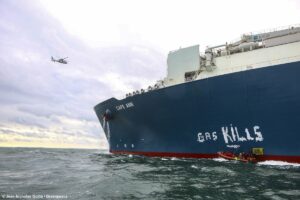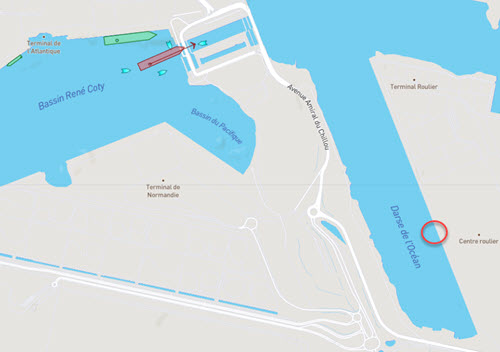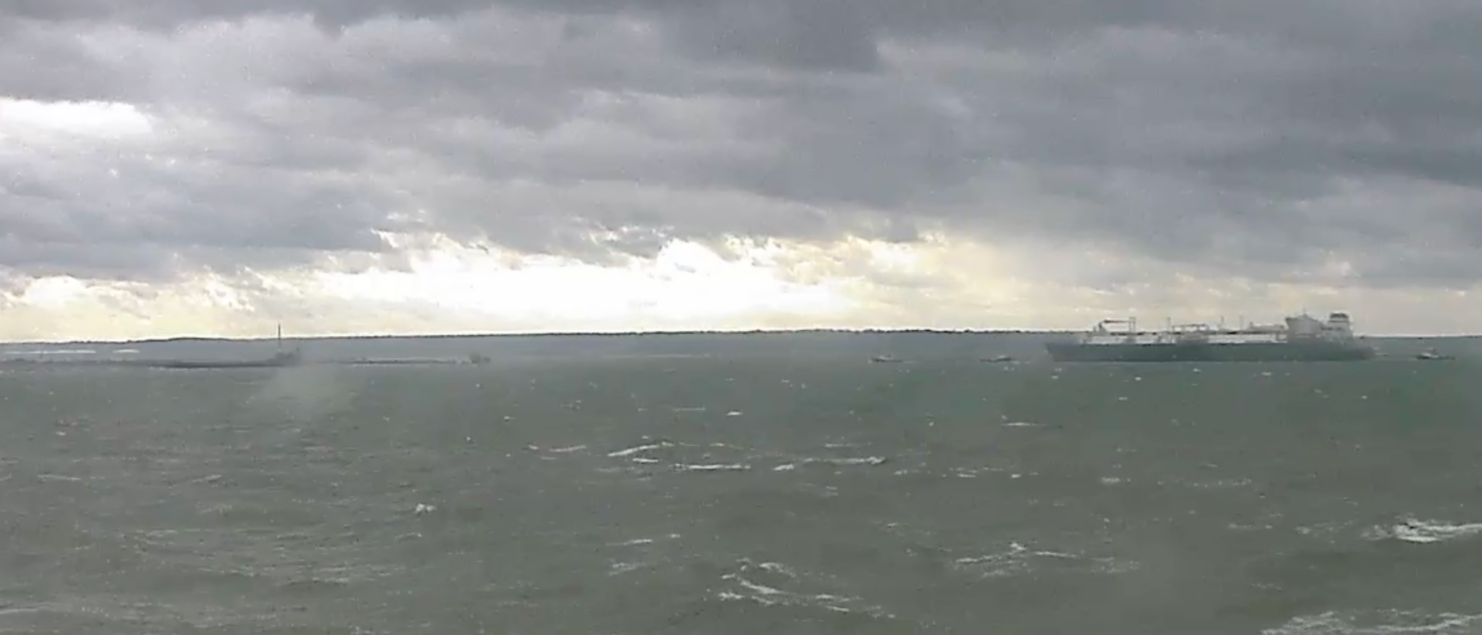Startup of the new Le Havre LNG terminal – with the Cape Ann FSRU
We don’t normally comment on routine moves of FSRUs or LNGCs, but the arrival of 145,130 m3 Cape Ann on Monday, September 18th to the new bgv4 berth at Le Havre’s Haropa Port (near Hoegh Autoliners coincidentally) is significant. It is France’s first FSRU terminal and will enter service at a time when France’s natural gas storages are over 90% filled, nuclear power plants are returning to service and energy prices are a fraction of what they were last year. The Hoegh/TotalEnergies ship enters on a 5-year sub-let to TotalEnergies new subsidiary TELSF, created as an operating vehicle for this purpose.
Cape Ann had a rather unusual route from its previous long FSRU assignment at Tianjin, China. Just off Sri Lanka it changed course to pick up a cargo in Nigeria for Revythoussa, Greece at the end of July. It then idled near Gibraltar until the beginning of September, when it was changed to be France-registered.
To finally prepare for the new FSRU service Cape Ann then sailed to the Sagunto LNG regas terminal in Spain, just like sister ship Neptune did in January for its service at Lubmin, Germany. While Neptune had to enter shallow-port Lubmin empty and deballasted, Cape Ann received a STS (ship-to-ship) cargo transfer in Gibraltar port on Monday the 10th of September from Seapeak Arwa. Seapeak Arwa had picked up a TotalEnergies equity cargo at Hammerfest Melkøya LNG, Norway at the end of August.
STS LNG transfer from Seapeak Arwa to Cape Ann on 10 Sep. 2023
Cape Ann arrived the Haropa Port berth bgv4 on the 18th fully laden. However, a two-day Le Havre arrival delay was caused by a Rebellion Extinction event on the 16th, which had previously twice, unsuccessfully, tried legal means to stop the FSRU from entering. The final approach to the port, in rather rough seas, was done at speed without any stops. Still, Greepeace was on its side able to taint the ship in their usual rich English.
 Greenpeace tainting Cape Ann on Le Havre approach on 18 Sep. 2023
Greenpeace tainting Cape Ann on Le Havre approach on 18 Sep. 2023
We have pondered for a while how TotalEnergies would handle vetting of LNGCs to pass through the Le Havre Ecluse Francois 1er tidal locks and bridges, and then tug handling in the Darce d’Ocean basin to berth bgv4.
Le Havre port with old and new LNG sites
Perhaps with the exception of Puerto Escobar, Argentin, TotalEnergies may have the two most challenging FSRU locations in the world with Lubmin and Le Havre. The potential Le Havre problem is clearly solved for the first round, but it will be interesting to see if the long-term solution could turn out to be to move Cape Ann offshore/OPL for STSs there. As the STS with Seapeak Arwa could suggest, in terms of matching ship sizes, logistics and cargo availabilities at least, Cape Ann may also be particularly suited for cargoes from Hammerfest.
 Cape Ann in Le Havre Ecluse Francois 1er locks, new FSRU site
Cape Ann in Le Havre Ecluse Francois 1er locks, new FSRU site
When it entered Le Havre port Cape Ann met fully prepared shore installations and a new 3.5 km GRTgaz-built and operated pipeline connection that runs north across the Hoegh Autoliners area, then underneath the Grand Canal du Havre to connect to the existing GRTgaz system. While the new entry point is not yet listed on GIE ALSI or Entsog transparency data platforms, we expect initial regasification and grid feed tests to take place very soon, and probably with the aim for 1 Oct. commercial start, with data availability shortly thereafter.
However, challenges to new FSRU operations have appeared in both Germany and Italy in 2023 and we do not expect France to be different also going forward. In particular, Cape Ann uses closed-loop regasification (i.e. the burning of natural gas for LNG vaporization, and not seawater), and boiloff flaring can be an issue, i.a. when the FSRU utilization is low. In a highly populated city area such as Le Havre, these factors may give rise to protests against noise and light pollution similar to what has been seen this year at Elbehafen, Germany with the Hoegh Gannet FSRU and the Neptune at Lubmin. In fact, Neptune at Lubmin will be moved to neighboring Mukran port at the end of 2023 in part because of this.
The reopening of Le Havre as an LNG import location is symbolic since the original terminal was closed in 1989 following the build-up of substantial new volumes of Russian natural gas, under the Urengoi contracts, into France. While France continues to import some LNG from Yamal LNG, the arrival of Cape Ann at Le Havre is a key element in France’s and Europe’s reorientation away from Russian natural gas.
However, with the described operationally challenging parameters and improved European gas balances we will not be surprised to see the primary contribution of the new Le Havre LNG terminal to be as a reserve and seasonal peaking facility close to demand centers. Despite this, the FSRU will undoubtedly remain a red flag for the usual action groups.
